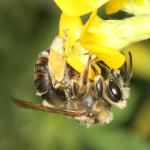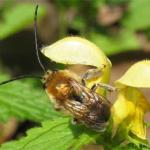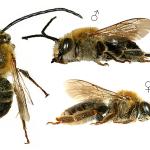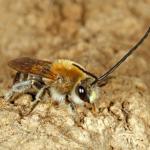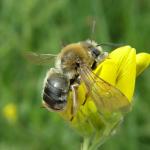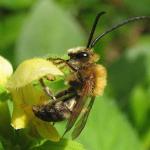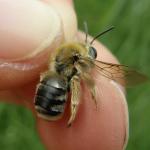Eucera tuberculata (FABRICIUS 1793); Eucera difficilis DUFOUR, FRIESE & PÉREZ 1896; Eucera atricollis FRIESE 1922
The extraordinarily long antennae of male Eucera species (when laid back these reaching the apex of the gaster) readily distinguish these bees from males of any other British bee genus. The male clypeus and labrum are bright yellow. In the female, the antennae are considerable shorter, when laid back their distal segments only reaching the scutellum; head entirely black.
Very local but sometimes numerous where found in southern England and south Wales. This species does not occur in Ireland. Widespread in Eurasia, the range extending east to Siberia and China (Wu 2000). A map illustrating its distribution within the western Palaearctic has been published (Kullenberg, Buel & Tkalcu 1984).
Listed as a Notable A species by Falk (1991).
Coastal grasslands (including cliffs and landslips), open rides in deciduous woodland and, occasionally, heathlands.
Univoltine, mid May to mid July, exceptionally August.
Nest burrows are generally found in aggregations in sparsely vegetated or eroded soil. The nest architecture of this species has been described by Smith (1846, 1876), J C Nielsen (1902) and E T Nielsen (1941). The winter is spent as a diapausing prepupa (Smith 1846, 1876). However, in late August, F W L Sladen excavated a nesting aggregation of this species in east Kent and counted 180 cocoons (Sladen 1895). Of these, 54 contained fully developed bees, the remainder prepupae. It is thus possible that the species may pass the winter in both of these stages.
In western Europe, these include bloody crane’s-bill (Geranium sanguineum), bramble (Rubus fruticosus agg.), bugle (Ajuga reptans), bush vetch (Vicia sepium), comfrey (Symphytum spp.), common bird’s-foot-trefoil (Lotus corniculatus), early-purple orchid (Orchis mascula), heather (Erica sp.), heath milkwort (Polygala serpyllifolia), kidney vetch (Anthyllis vulneraria), lucerne (Medicago sativa), narrow-leaved everlasting-pea (Lathyrus sylvestris), radish (Raphanus spp.), red clover (Trifolium pratense), tuberous pea (Lathyrus tuberosus), white clover (Trifolium repens), meadow vetchling (Lathyrus pratensis). Bees also visit Boraginaceae, Lamiaceae and Liliaceae (Móczár 1954). On mainland Europe, the males of this bee are occasional pollinators of the bee orchid (Ophrys apifera) and late spider orchid (Ophrys fuciflora)(Kullenberg, Buel & Tkalcu 1984). The bees mistake the flowers for their own species and attempt to couple, the labellum of the flower acting as a copulatory dummy.
The very rare bee, Nomada sexfasciata is a cleptoparasite (e.g. Smith 1846). This Nomada is currently known from only a single site on the south coast of Devon, where bees have been observed flying about the nest burrows of E. longicornis (pers. obs.).
Proofed: February 2012


